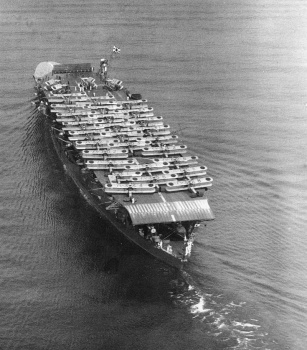Post by Diarist on Mar 12, 2017 4:20:09 GMT 1
Construction and launch
Akagi was laid down as an Amagi-class battlecruiser at Kure, Japan, on 6 December 1920. The ship was named after Mount Akagi, following the Japanese ship-naming conventions for battlecruisers. Construction was halted, however, when Japan signed the Washington Naval Treaty on 6 February 1922. The treaty placed restrictions on the construction of battleships and battlecruisers although it authorized conversion of two battleship or battlecruiser hulls under construction into aircraft carriers of up to 33,000 long tons (34,000 t) displacement. The IJN had decided, following the launch of its first aircraft carrier, Hōshō, to construct two larger, faster carriers for operations with major fleet units. The incomplete hulls of Amagi and Akagi were thus selected for completion as the two large carriers under the 1924 fleet construction program. ¥24.7 million was originally budgeted to complete Akagi as a battlecruiser and an estimated ¥8 million had been expended when construction stopped in February 1922. Shortly thereafter, the Diet approved an additional ¥90 million to complete Akagi and Amagi as carriers.
Construction of Akagi as an aircraft carrier began on 19 November 1923. Amagi's hull was damaged beyond economically feasible repair in the Great Kantō earthquake of 1 September 1923 and was broken up and scrapped. Akagi, the only remaining member of her class, was launched as a carrier on 22 April 1925 and commissioned at Kure Naval Arsenal on 25 March 1927, although trials continued through November 1927. She was the second carrier to enter service with the IJN, after Hōshō and before Kaga (which replaced Amagi).
Since Akagi was initially conceived as a battlecruiser, the prevailing ship naming conventions dictated that she (like her sister ships) be named after a mountain. Akagi came from Mount Akagi, a dormant volcano in the Kantō region (the name literally means "red castle"). After she was redesignated as an aircraft carrier, her mountain name remained, in contrast to ships like Sōryū that were originally built as aircraft carriers, which were named after flying creatures. Her name was previously given to the Maya-class gunboat Akagi.
Akagi was completed at a length of 261.21 meters (857 ft 0 in) overall. She had a beam of 31 meters (101 ft 8 in) and, at deep load, a draft of 8.08 meters (26 ft 6 in). She displaced 26,900 long tons (27,300 t) at standard load, and 34,364 long tons (34,920 t) at full load, nearly 7,000 long tons (7,100 t) less than her designed displacement as a battlecruiser. Her complement totalled 1,600 crewmembers.
Early service
Akagi joined the Combined Fleet in August 1927 and was assigned to the First Carrier Division upon its formation on 1 April 1928, serving as the division's flagship under Rear Admiral Sankichi Takahashi. The carrier's early career was uneventful, consisting of various training exercises. From 10 December 1928 to 1 November 1929, the ship was captained by Isoroku Yamamoto, future commander of the Combined Fleet.
Akagi was reduced to second-class reserve status on 1 December 1931 in preparation for a short refit in which her arresting gear was replaced and her radio and ventilation systems were overhauled and improved. After completion of the refit, Akagi became a first-class reserve ship in December 1932. On 25 April 1933, she resumed active service and joined the Second Carrier Division and participated in that year's Special Fleet Manoeuvers.
At this time, the IJN's carrier doctrine was still in its early stages. Akagi and the IJN's other carriers were initially given roles as tactical force multipliers supporting the fleet's battleships in the IJN's "decisive battle" doctrine. In this role, Akagi's aircraft were to attack enemy battleships with bombs and torpedoes. Aerial strikes against enemy carriers were later (beginning around 1932–1933) deemed of equal importance, with the goal of establishing air superiority during the initial stages of battle. The essential component in this strategy was that the Japanese carrier aircraft must be able to strike first with a massed, pre-emptive aerial attack. In fleet training exercises, the carriers began to operate together in front of or with the main battle line. The new strategy emphasized maximum speed from both the carriers and the aircraft they carried as well as larger aircraft with greater range. Thus, longer flight decks on the carriers were required in order to handle the newer, heavier aircraft which were entering service. As a result, on 15 November 1935 Akagi was placed in third-class reserve to begin an extensive modernization at Sasebo Naval Arsenal.
Source: Wikipedia - en.wikipedia.org/wiki/Japanese_aircraft_carrier_Akagi

